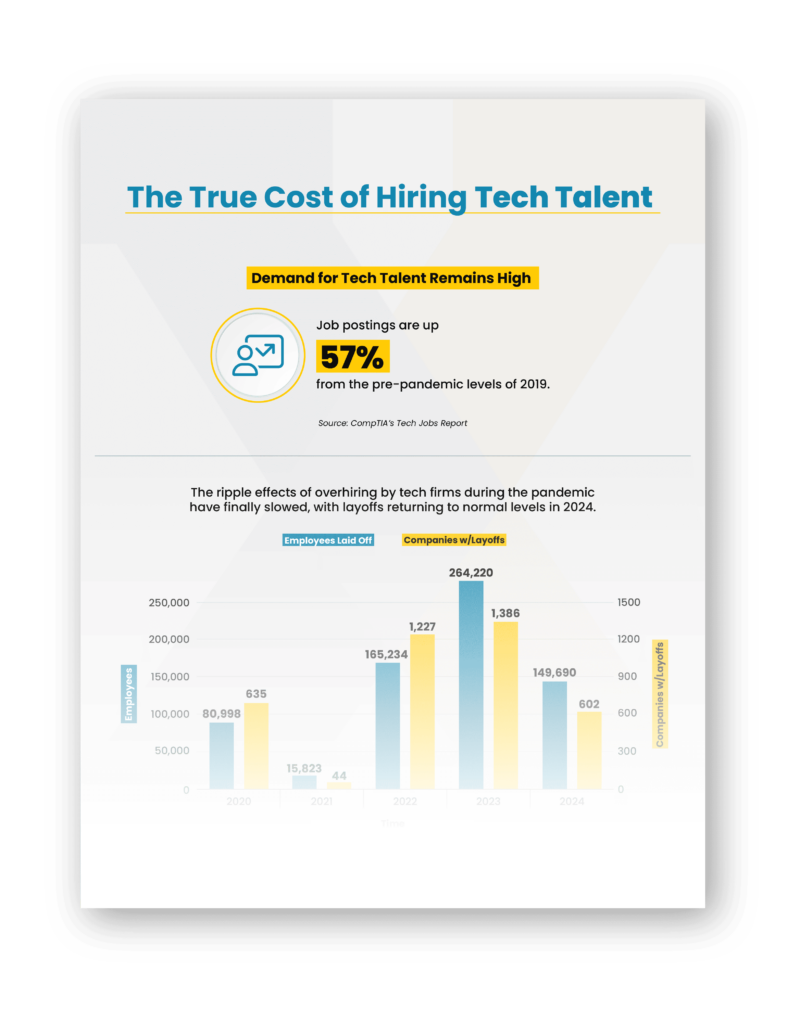In brief:
- IT outsourcing is increasing rapidly as 57% of hiring managers struggle to find skilled IT talent, even as 43% plan to increase the size of their IT staff in 2025.
- 37% of companies expect spending on IT outsourcing to increase in the next three years, with IT infrastructure services, application development, and cybersecurity ranking as the most outsourced functions.
- IT outsourcing averages 85% success at achieving equivalent or superior service, with web operations, cloud infrastructure management, and data center operations ranking at the top.
- Companies prioritize proximity, data residency, and communication among IT outsourcing providers over the lowest cost, pointing to the benefits of nearshoring vs. offshoring.
Managing enterprise information technology staff, infrastructure, and services is challenging in the best circumstances. However, these difficulties are growing along with the exploding demand for mission-critical support and digital transformation. Many IT departments are stretched thin as they struggle to control budgets, operate, and support business initiatives, while recruiting and retaining workers with the right skills.
Some 57% of hiring managers are finding it “difficult to find skilled IT talent,” even while 43% of companies say they plan to increase the size of their IT staff in 2025. This shows a significant demand and supply gap for IT workers – indicating a clear need for cost-efficient and effective solutions.
More than half of IT workers (58%) say they feel overwhelmed by their daily responsibilities and tasks, with the average IT worker reporting they only have the capacity to support 85% of the tickets they receive each day, according to a study by GoTo and conducted by OnePoll. Advancing AI and automation are expected to ease the burden somewhat, but 77% of employees say using AI has added to their workload in the short term and created challenges in achieving expected productivity gains, a study from The Upwork Research Institute found.
In this scenario, IT outsourcing is emerging as an increasingly viable and rapidly growing option.
Read on to learn about the increasing use of external resources, the success rate and cost savings for different tasks, and other vital trends in IT outsourcing.
The evolving benefits of IT outsourcing
The days of IT being a distinct support function and secondary budget item are gone. Today’s tech demands are broader and inextricably tied to core business operations. At the same time, resource-sensitive leaders need to account for rising costs amid a skilled labor shortage, technological advancements and steep adoption curves, and economic uncertainty.
Successful IT outsourcing addresses many of these issues, and more companies have become comfortable with the model after the post-pandemic rise in remote and hybrid work. In a top IT outsourcing market like Colombia, Mexico, or Costa Rica, outsourcing provides a skilled talent pool and readily available infrastructure to increase organizational efficiency while costing less than in-house resources.
Common use cases and benefits of partnering with an IT outsourcing company include:
- Reducing service costs and capital expenditures.
- Supporting or accelerating the flexible deployment of services, a strong operating framework, and digital transformation.
- Outsourcing essential yet straight-forward functions like day-to-day operations, freeing up in-house personnel to focus on strategic and cutting-edge initiatives to better support the business.
- Helping to realize the promise of artificial intelligence (AI) today by accelerating automation that drives efficiency. The right outsourcing partner will bring the newest technologies that improve customer experience, streamline operations, and improve productivity.
- Serving as a modular “plug-and-play” solution that addresses IT needs while lessening the burden on strategic employees.
- Accessing specialized resources to manage the increasing complexity of IT environments characterized by fast-changing technologies, an increasing number of workloads shifting to the cloud, an explosion of SaaS solutions, and more.
In addition to helping generate operational efficiencies, IT outsourcing is also often an attractive cost efficiency. The savings of not expanding in-house resources or building them from the ground up can be significant – especially in markets like Latin America that combine deep pools of highly skilled tech talent with substantial labor arbitrage compared to the U.S.
These benefits explain why current IT trends show rising interest in IT outsourcing services, and business process outsourcing in general. However, cost savings should accompany maintaining or improving service levels—and strategically choosing the right function and outsourcing provider is key to achieving desired benefits.
2025 trends in IT outsourcing and what they mean for your business
1. IT outsourcing demand is surging
Avasant Research’s Computer Economics surveyed 146 large, small, and midsize IT organizations in the U.S., Canada, and Europe for its latest “IT Outsourcing Statistics Report.”
The report reveals that spending on outsourcing as a proportion of IT operational budgets grew 45% between 2022 and 2023 (5.6% vs. 8.1%). The 2023 spending eclipsed the five-year average by nearly 22% (8.1% vs. 6.66%).
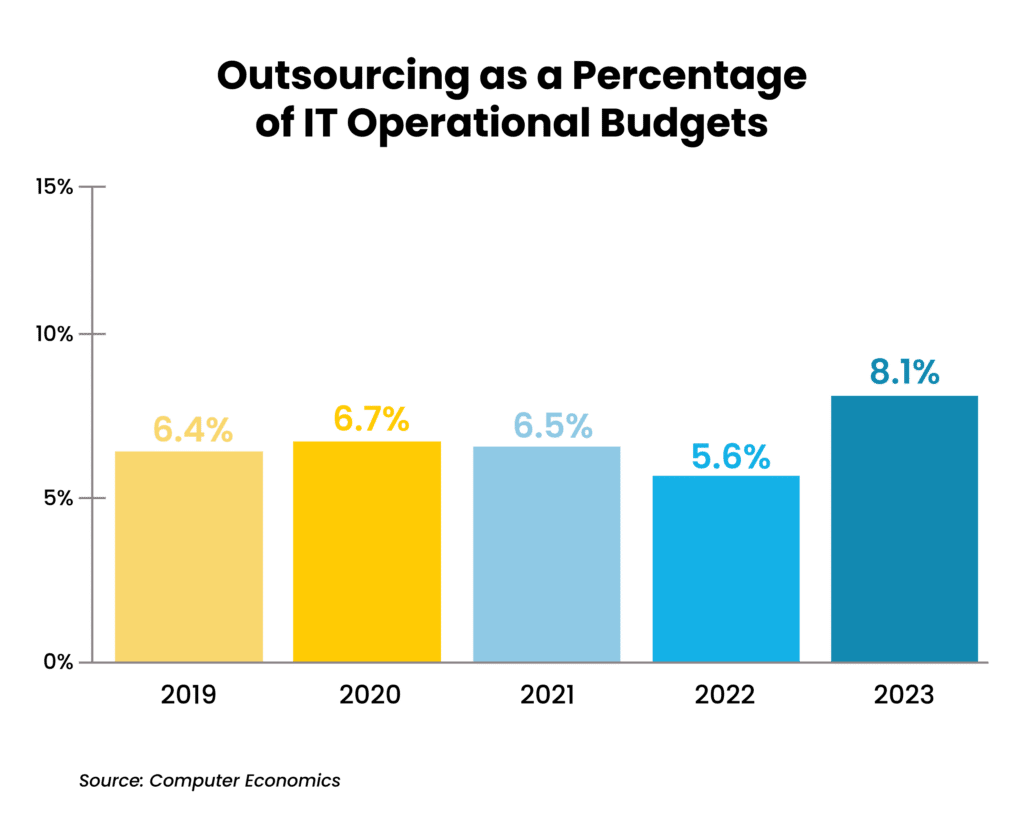
In addition, 37% of companies expect their spending on IT outsourcing will increase in the next three years. This aligns with findings from Deloitte’s 2024 Global Outsourcing Survey, which found that 40% of business and tech leaders expect to increase investments in third-party outsourcing.
This number may accelerate as use cases and successful adoptions grow.
More than 30% of organizations surveyed by Computer Economics anticipate using more IT outsourcing companies over the next three years, and 40% project contract sizes will increase.
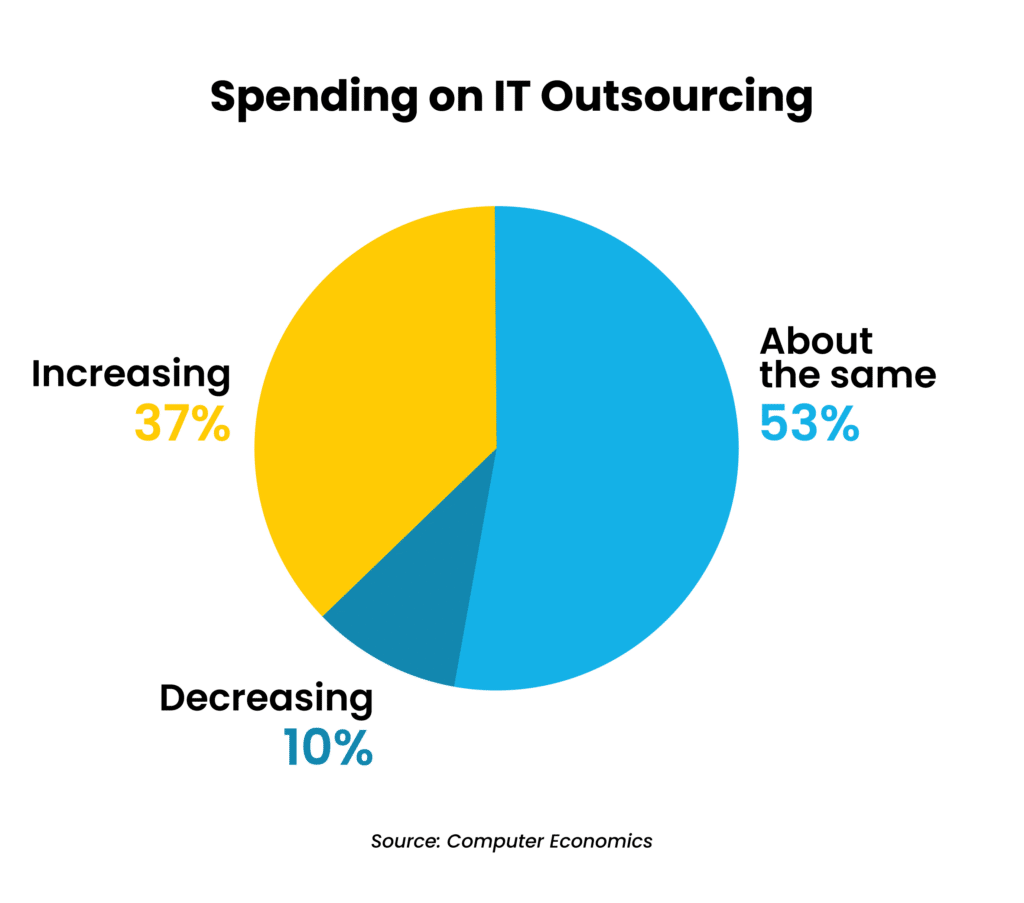
John David-Lovelock, a research vice president and analyst at Gartner, told Computer Weekly that he believes this IT outsourcing trend will accelerate. By 2027, in most industries, 50% more will be spent on IT contractors compared with internal IT staff, driven by the CIO’s inability to retain higher-skilled staff. “There is a lot more technology coming up that needs higher skill sets,” he added.
Outsourcing frequency and levels for critical IT functions
Recurring themes drive why companies are looking for outsourcing partners: cost savings, adaptability, reduced infrastructure requirements, and addressing a tight labor market.
However, what organizations outsource can vary significantly based on their needs. Nevertheless, some notable trends exist among IT functions, with the potential for reducing expenses and the ease of bringing in outside help playing substantial roles in the decision.
Computer Economics’ report breaks down 11 IT functions that companies outsource into two metrics:
- Frequency: the percentage of organizations that at least partially outsource an IT function.
- Level: the percentage of total work outsourced by those that outsource the function.
The average outsourcing frequency among companies across 11 IT functions is over 51%, showing that outsourcing tends to be at least partially used across all areas. The top three use cases are application development (64%), cloud infrastructure management (62%), and data center operations (54%).
Deloitte found an even greater percentage of these functions were outsourced in 2024, with IT infrastructure services coming in at 77% and application development at 72%. Cybersecurity also entered Deloitte’s top 3 in 2024 – ranking with IT infrastructure services as the most outsourced IT functions, at 77%.
This comes as no surprise: cyberthreats topped the list of business risks for enterprises worldwide even as they struggle to find the required skillsets in-house. The third quarter of 2024 saw the average number of weekly attacks per organization climb to an all-time high of nearly 1,900, according to Check Point’s 2025 Cyber Security Predictions, a staggering 75% increase from a year earlier. The increased frequency of attacks, combined with the labor shortage and security tool sprawl, make security operations a great candidate for outsourcing.
The other top functions outsourced also make sense. Software development may require specific skill sets to develop customized solutions for novel business requirements, calling for outside provider assistance. And cloud infrastructure management and data center operations reflect the growing demand for these tasks and the quick scalability required.
Desktop support (52%), application management (52%), and help desk (50%) round out the top six functions rating at least halfway partial outsourcing adoption in the Computer Economics report. These areas present opportunities for efficient service and cost savings compared to in-house solutions, freeing up personnel for specific and strategic initiatives.
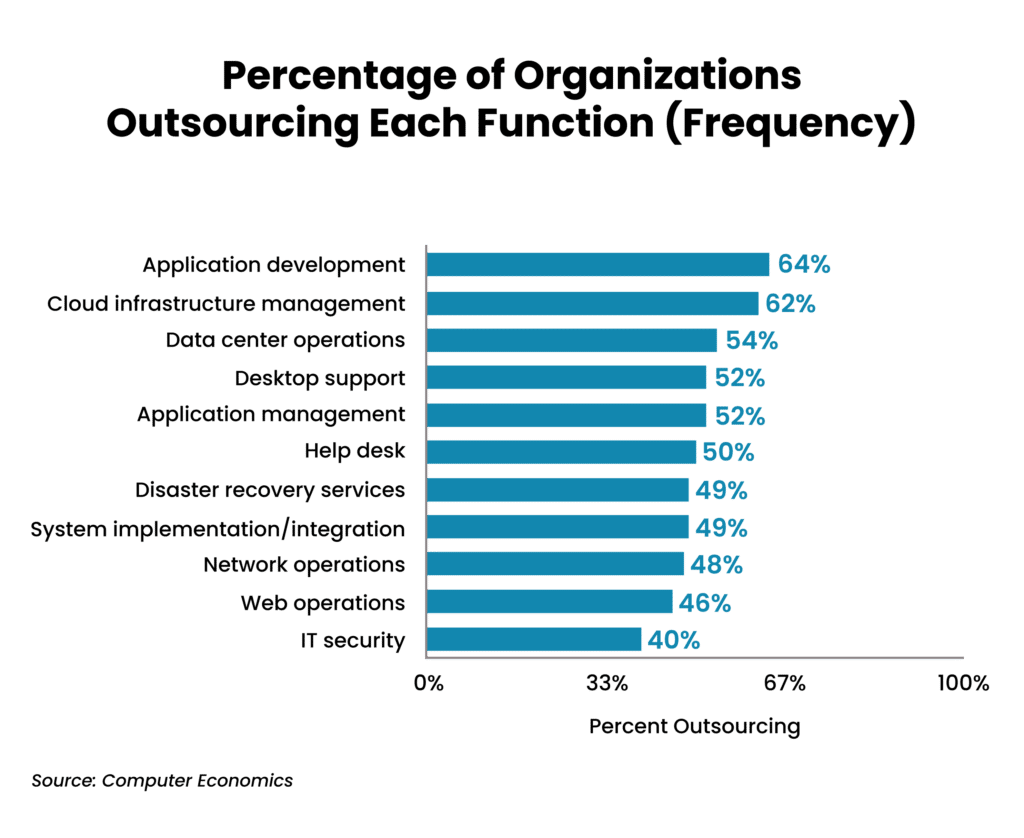
When we look at the level of outsourcing among organizations, the rankings shift. Overall, the average proportion of work outsourced across all 11 areas is just under 45%.
Outsourced help desk (55%), desktop support (55%), and disaster recovery services (53%) represent over half of organizations’ total workloads in those areas. Cloud infrastructure (48%) and web operations (47%) round out the top five.
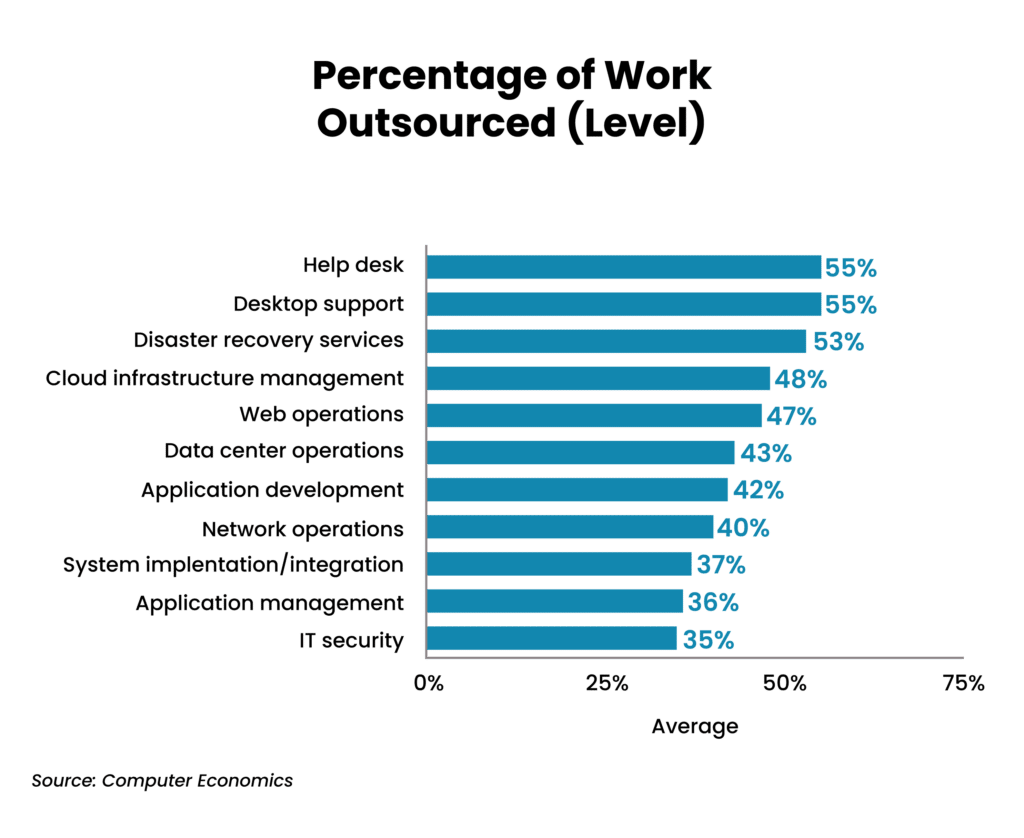
One reason the top five have higher total usage rates is that they are all well-established, mature outsourcing functions. The ease of using external solutions compared to the difficulty of developing in-house resources presents a compelling business case.
In addition, several of these areas have a proven track record of success in reducing operational costs, which we’ll cover shortly.
We are also seeing IT outsourcing levels rise steadily in recent years as enterprises increasingly look to outsourcing providers for long-term, strategic partnerships instead of simple operational support – and become more comfortable outsourcing more complex business processes. Deloitte’s latest Global Shared Services and Outsourcing Survey reports that 57% of shared services centers currently perform IT processes, up from 47% in 2019 – making IT the third-most common shared services function.
2. IT outsourcing reduces costs across the board – with a 91% success rate for help desk
Lowering IT expenses is a dominant goal among companies that use external resources. It’s achieved through reducing direct, highly measurable costs like cloud infrastructure management and avoiding indirect expenses, such as lost institutional knowledge after employee turnover. Overall, IT outsourcing’s success at maintaining or reducing costs is clearly a “good news” story.
Computer Economics defines cost success as “when outsourcing a function costs the same as or less than performing the function in-house.” The average success of all 11 functions is just over 74%, presenting a compelling case for keeping expenses in check. Every area achieved a success rate above 60%.
However, there are some clear standouts, particularly help desk (91%) and desktop support (83%). Web operations (79%), data center operations (78%), and cloud infrastructure management (76%) comprise the rest of the top five:
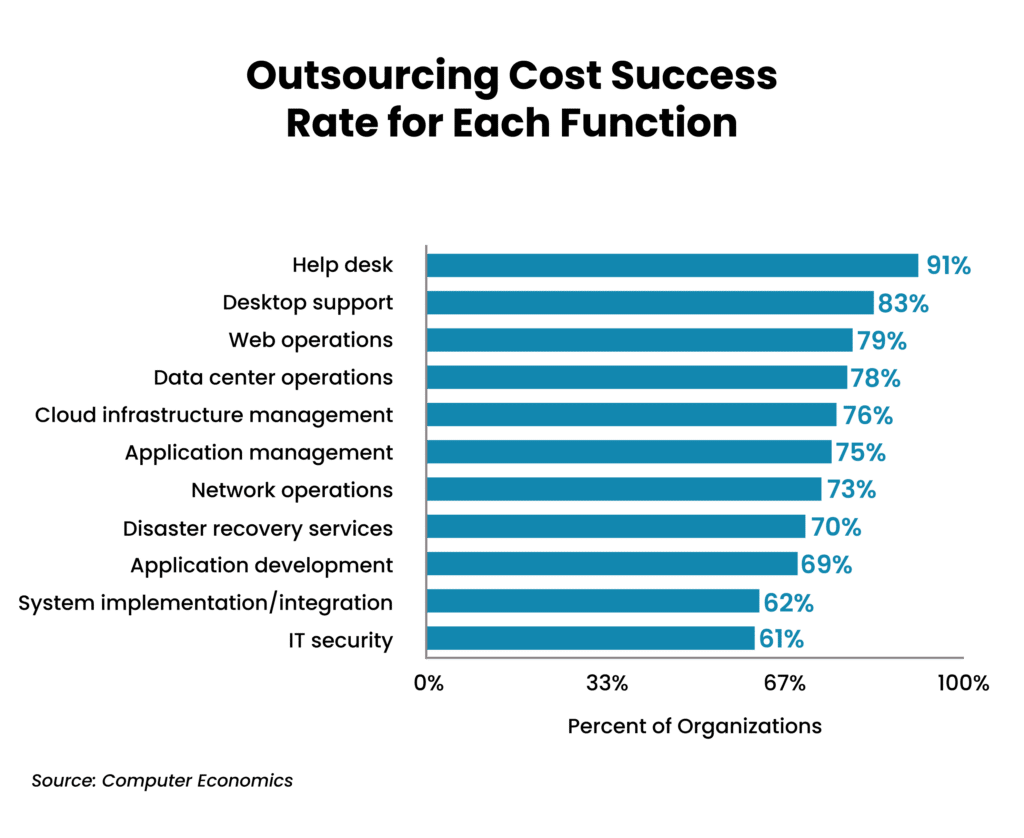
Companies tend to outsource help desk and desktop support because these areas are mature, highly scalable, and often more efficient than dedicating in-house staff. Quality external service desk solutions typically have more resources to serve clients’ needs, including a broader range of expertise, optimized operations, and streamlined ticketing processes.
Crucially, the overhead for both an outsourcing client and a provider can be lower when nearshore or offshore resources are involved. Clients can gain access to skilled people and emerging technologies like intelligent process automation and Generative AI as part of the service contract, while providers leveraging competent but lower-cost personnel in top IT outsourcing markets like Mexico or Colombia can charge less.
Application development (69%), system implementation/integration (62%), and IT security (61%) had the lowest success rates in lowering or maintaining costs, though each still had an attractively high rate.
3. IT outsourcing averages 85% success at improving or maintaining service
Paying less and accessing in-demand skills in a tight labor market are significant outsourcing drivers, but they aren’t the only factors. Companies also want better service than they have or could achieve with an in-house solution – or at least equivalent service levels at less cost.
Computer Economics defines service experience success “as obtaining a service level that is the same as or better than what is achieved using in-house resources.”
Again, the overall results are very positive: the average service experience success rate is 85% across the 11 functional areas. No area achieved less than 75%:
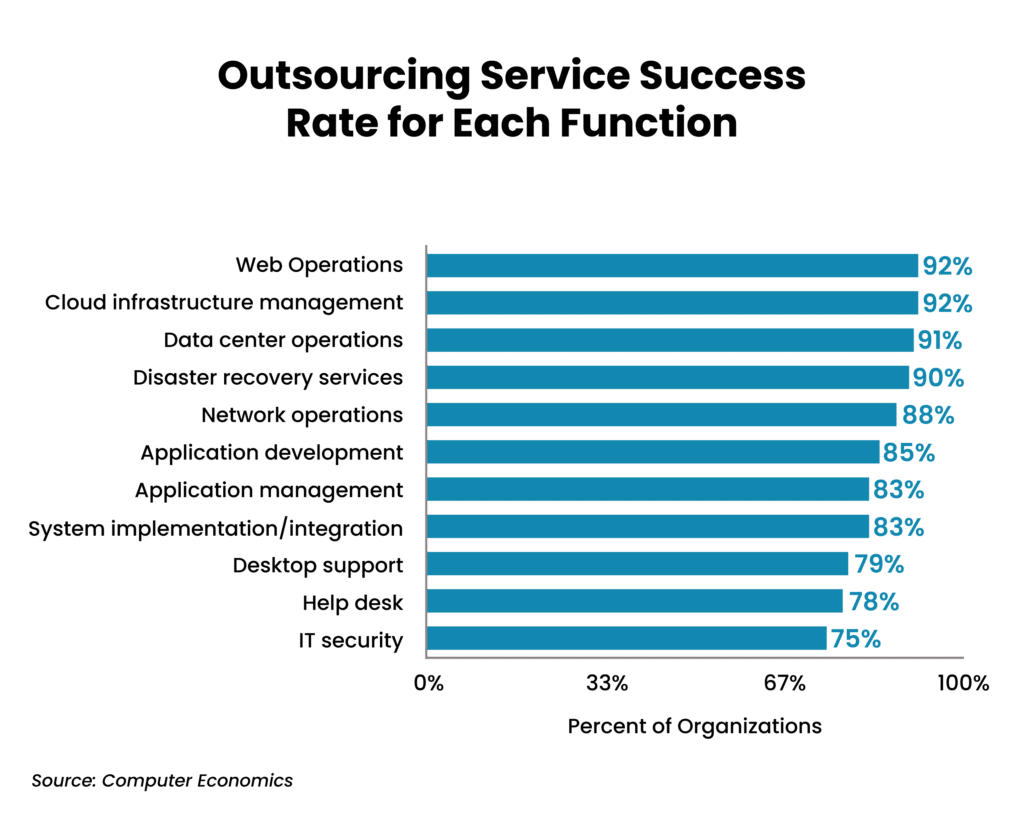
Among the top five successful areas, web operations (92%), cloud infrastructure management (92%), and data center operations (91%) are notable for also coming in among the top five in cost reduction or maintenance (79%, 76%, and 78%, respectively). Collectively, these two metrics point to clear opportunities to employ consistent, mature outsourcing functions.
Notably, the service experience success rates of help desk and desktop support (78% and 79%) scored lower than their cost-reduction success rates (91% and 83%). While 78% and 79% are still relatively high numbers, the disparity between cost reduction and service success in help desk and desk support highlights the importance of choosing an experienced and quality outsourcing provider.
For example, some of the lowest-cost providers concentrated in specific parts of the world don’t provide the best service, as we’ll explain next.
Here is the complete analysis of all areas:
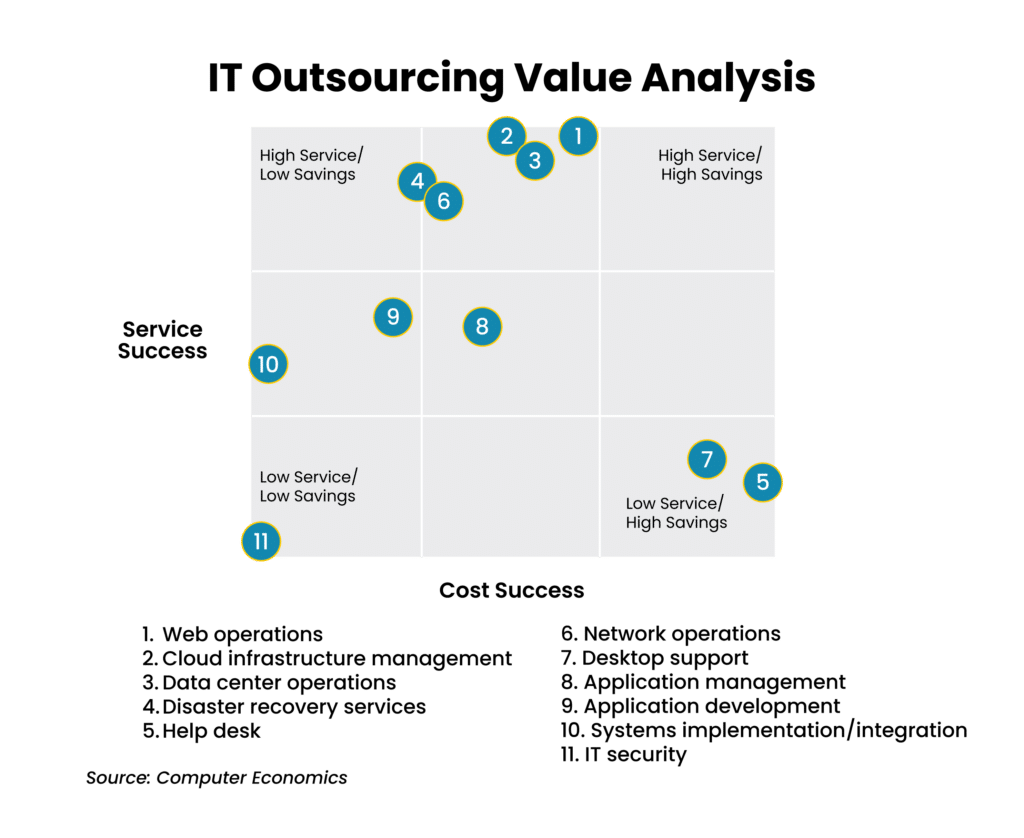
4. Emerging trends in IT show a preference for nearshore outsourcing
It simply doesn’t “pay” to save money on IT while experiencing bottlenecks and slowdowns that negatively impact operations and worsen a company’s employee experience.
For example, a Censuswide/Freshworks survey found that 91% of employees are frustrated by “inadequate” workplace technology, and 57% say it makes them less productive. Not surprisingly, nearly a quarter of IT professionals (23%) say a colleague has resigned due to burnout.
Companies must find outsourcing solutions that balance lower expenses and good service. Interestingly, many IT functions that offer the greatest cost savings but average or below-average service experiences present the best opportunities. Companies can achieve both goals with the right outsourcing provider.
The first and vital step in choosing a quality external partner is closely evaluating their services and genuine capabilities, in addition to what they charge. However, the Computer Economics report provides insights that help narrow this search. The survey asked company leaders to rank the “most important attributes in choosing a service provider” from one to five. And the latest IT nearshoring and IT offshoring trends show that the top priorities explicitly depend on geography.
Crucially, “low cost” comes in last. The reduced operational challenges resulting from where the provider and any data are located, how well support staff communicate, and how well their time zone matches dominate the decision:

Everyone who has experienced customer support in their daily lives can appreciate the difficulty of requesting complex answers from someone who can’t communicate well in English. And anyone who needs to solve an emerging data center problem, cloud computing issue, or cyberattack doesn’t relish the idea of contacting thin support staff on the other side of the world at 3 a.m. in Asia—or having to wait until business hours begin in distant time zones.
Asia’s saturated labor markets also make it difficult to hire and retain top tech talent for the overnight shifts that align with U.S. business hours—impacting service quality.
These proximity and communication preferences (within the context of cost reduction) illustrate the value of nearshoring instead of offshoring with far-flung providers in India or the Philippines. They also explain why Latin American providers have become a preferred solution for North American businesses.
Over the course of 2023, U.S. companies have ramped up their year-over-year hiring in Latin America by a staggering 50%, according to international hiring and payments provider Deel.
5. Nearshoring IT prioritizes exceptional service and significant cost savings
IT outsourcing has evolved from a novel, discrete cost savings tactic to an integral part of many companies’ strategies. In many cases, external support is necessary, providing skilled labor and technology that would otherwise be impossible to acquire in-house. A rapidly growing number of enterprises depend on IT outsourcing to support mission-critical areas.
However, some IT functions have a track record of more easily integrating external services than others, often due to the customization required and the maturity of an outsourcing model. All functional IT areas show relatively high cost-reduction and service success rates, but the best opportunities offer both. Nearshoring IT services instead of offshoring to Asia or relying on domestic providers can help achieve this balance.
North American companies that nearshore IT from tech hubs like Colombia, Mexico, and Costa Rica benefit from a highly skilled labor pool, mature infrastructure and experience with critical technology like robotic process automation (RPA) and AI, excellent communication skills, outstanding English fluency, high affinity with U.S. business practices and culture, and the right time zones.
Nearshoring makes sense from a cost perspective as well – average wages of tech employees in Latin America are just about 38% of those in the U.S., according to the 2024 CBRE Scoring Tech Talent. Overall labor arbitrage averages 30-50% in LATAM, although savings can vary by country.
The right nearshoring provider can help the budget and the service experience while providing scalable, top-quality IT solutions.
Want to learn more about how nearshore IT outsourcing can support your business needs? Schedule a consultation with our IT outsourcing leaders today! Or visit our resource center to learn more IT outsourcing trends, strategies, and success stories.
Frequently Asked Questions
What are the latest IT outsourcing industry trends?
What are the benefits of outsourcing IT services?
What are the potential risks associated with IT outsourcing?
How can businesses choose the right IT outsourcing partner?
What are the cost considerations in IT outsourcing?
How does IT outsourcing affect company culture?




